| Article ID | Journal | Published Year | Pages | File Type |
|---|---|---|---|---|
| 4050429 | Clinical Biomechanics | 2014 | 8 Pages |
•Spinopelvic instrumentations of 6 neuromuscular scoliosis were simulated and biomechanically analyzed.•Lateral connectors and sacral screws had significant effects on loads at iliac screws.•Inserting iliac screws from the sacrum through the iliac crest and avoiding lateral connectors reduce loads on iliac screws.•Cross-rod connectors do not have significant effect on the loads at iliac screws.•It is possible to reduce the iliac screw loads by adapting instrumentation variables and strategies.
BackgroundHigh rates of iliac screw fixation failures have been reported in spinopelvic instrumentations. The objective was to assess the iliac screw loads as functions of instrumentation variables.MethodsSpinopelvic instrumentations of six neuromuscular scoliosis were simulated using patient-specific modeling techniques to evaluate the intra- and postoperative iliac screw loads as functions of instrumentation variables: the combined use of sacral screws, the uses of lateral offset connectors and cross-rod connectors, and the iliac screw insertion point and trajectory.FindingsSacral screws, lateral connectors and the iliac screw insertion point had significant effects on iliac screw axial forces (69–297 N) and toggle moments (0.8–2.9 N m) (p < 0.05). The addition of sacral screws made the iliac screw forces lower for some functional loads but higher for other functional loads, and resulted in an increase of intraoperative screw forces when attaching the rods onto these additional screws. When lateral offset connectors were used, the toggle moments were 16% and 25% higher, respectively for the left and right sides. Inserting iliac through the sacrum resulted in 17% lower toggle moment compared to insertion through the iliac crest. Cross-rod connectors had no significant effect on the intraoperative iliac screw forces. Postoperative functional loading had an important effect (additional 34% screw axial force and 18% toggle moment).InterpretationIt is possible to reduce the iliac screw loads by adapting instrumentation variables and strategies. Reducing the loads could decrease the risk of failure associated with iliac screw fixations.
